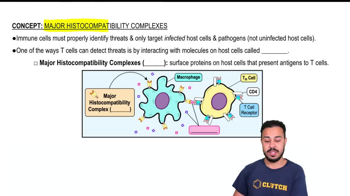Here are the essential concepts you must grasp in order to answer the question correctly.
Nuclear Localization Signal (NLS)
A Nuclear Localization Signal (NLS) is a specific amino acid sequence that enables proteins to be recognized and transported into the nucleus by the nuclear transport machinery. This signal is essential for proteins that function within the nucleus, as it directs their movement through the nuclear pore complex, which selectively allows the passage of molecules based on their signals.
Recommended video:
Step 2: Release of Inflammatory Mediators & Other Cytokines
Nuclear Pore Complex (NPC)
The Nuclear Pore Complex (NPC) is a large protein structure embedded in the nuclear envelope that regulates the transport of molecules between the nucleus and the cytoplasm. It allows the passage of small molecules freely while requiring specific signals, like an NLS, for larger proteins to enter the nucleus, thus playing a critical role in cellular compartmentalization.
Recommended video:
Major Histocompatibility Complexes
Protein Segmentation and Function
Protein segmentation refers to the division of a protein into distinct functional regions, such as a core segment and a tail segment. In the context of nucleoplasmin, the core segment may contain the NLS necessary for nuclear entry, while the tail may have different roles. Understanding how these segments interact with cellular transport mechanisms is crucial for determining how proteins localize within the cell.
Recommended video:
Membrane Protein Functions
 Verified step by step guidance
Verified step by step guidance Verified Solution
Verified Solution



 4:13m
4:13m